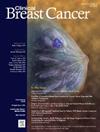根据种系致病或可能致病的遗传变异,遗传性乳腺癌患者肿瘤中HER2低水平的分布
IF 2.5
3区 医学
Q2 ONCOLOGY
引用次数: 0
摘要
目的:通过多基因检测面板检测HER2“低”亚型在高危遗传性乳腺癌中的表现。方法:这项前瞻性队列研究于2021年11月至2022年10月进行,纳入了在坎皮纳斯大学(UNICAMP)高危门诊就诊的女性,这些女性在45岁之前被诊断出或符合NCCN(版本3.2021)种系基因检测标准,或至少有1位一级亲属患有乳腺癌、卵巢癌和/或前列腺癌。患者在接受基因检测前完成一份问卷,并根据检测结果接受咨询。结果:共研究184例患者,198个乳房。36%(67/184)的患者检测到致病性或可能致病性变异(PV/LPV)。综合分析,以HER2 +3为参照,其他HER2表达与PV/LPV的相关性如下:0 (OR = 5.58;Ci 2.29-13.58), +1 (or = 5.76;Ci 2.0-16.59), +2 (ish -), (or = 4.31;Ci 1.11-16.59), +2 (ish +) (or = 4.77;可信区间1.75 - -12.95)。仅在BRCA1和BRCA2基因的分析中,HER2 +2 (ISH-)亚型与PV/LPV无关;其他亚型的相关性包括0 (OR = 6.61;Ci 2.70-16.19), +1 (or = 5.01;Ci 1.68-14.94), +2 (ish +) (or = 3.63;可信区间1.35 - -9.82)。对于非brca基因,her20和HER2 + (ISH-)均与PV/LPV无关;然而,+1 (OR = 4.71;CI 1.25-17.67)和+2 (ISH +) (OR = 4.74;CI 1.32-17.01)显示相关性。结论:遗传性乳腺癌相关基因的致病性或可能致病性变异与不同的HER2表达模式相关,包括HER2 Low组。本文章由计算机程序翻译,如有差异,请以英文原文为准。
Distribution of HER2 Low in Tumors of Patients With Hereditary Breast Cancer According to Germline Pathogenic or Likely Pathogenic Genetic Variants
Objective
To evaluate the presentation of the HER2 “Low” subtype in high-risk hereditary breast cancer according to the presence of germline variants detected through a multigene panel.
Methods
This prospective cohort study, conducted between November 2021 and October 2022, included women attending the high-risk outpatient clinic at the University of Campinas (UNICAMP), who were diagnosed before age 45 or met NCCN (version 3.2021) criteria for germline genetic testing, or had at least 1 first-degree relative with breast, ovarian, and/or prostate cancer. Patients completed a questionnaire before undergoing genetic testing and received counseling based on their test results.
Results
A total of 184 patients and 198 breasts were studied. Pathogenic or likely pathogenic variants (PV/LPV) were detected in 36% (67/184) of patients. In general analysis, using HER2 +3 as the reference, other HER2 expressions were associated with PV/LPV as follows: 0 (OR = 5.58; CI 2.29-13.58), +1 (OR = 5.76; CI 2.0-16.59), +2 (ISH-), (OR = 4.31; CI 1.11-16.59), +2 (ISH +) (OR = 4.77; CI 1.75-12.95). In the analysis of BRCA1 and BRCA2 genes only, the HER2 +2 (ISH-) subtype was not associated with PV/LPV; associations for other subtypes included 0 (OR = 6.61; CI 2.70-16.19), +1 (OR = 5.01; CI 1.68-14.94), +2 (ISH +) (OR = 3.63; CI 1.35-9.82). For non-BRCA genes, neither HER2 0 nor HER2 + (ISH-) was associated with PV/LPV; however, +1 (OR = 4.71; CI 1.25-17.67) and +2 (ISH +) (OR = 4.74; CI 1.32-17.01) showed associations.
Conclusion
Pathogenic or likely pathogenic variants in genes associated with hereditary breast cancer are associated with different HER2 expression patterns, including the HER2 Low group.
求助全文
通过发布文献求助,成功后即可免费获取论文全文。
去求助
来源期刊

Clinical breast cancer
医学-肿瘤学
CiteScore
5.40
自引率
3.20%
发文量
174
审稿时长
48 days
期刊介绍:
Clinical Breast Cancer is a peer-reviewed bimonthly journal that publishes original articles describing various aspects of clinical and translational research of breast cancer. Clinical Breast Cancer is devoted to articles on detection, diagnosis, prevention, and treatment of breast cancer. The main emphasis is on recent scientific developments in all areas related to breast cancer. Specific areas of interest include clinical research reports from various therapeutic modalities, cancer genetics, drug sensitivity and resistance, novel imaging, tumor genomics, biomarkers, and chemoprevention strategies.
 求助内容:
求助内容: 应助结果提醒方式:
应助结果提醒方式:


